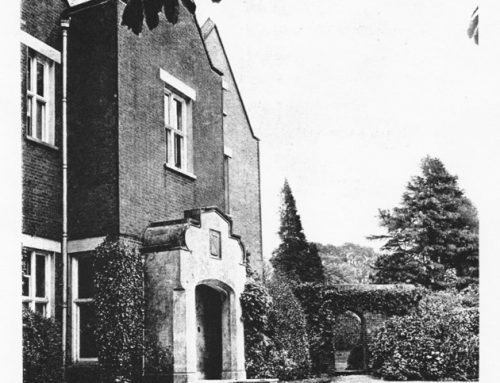The farms of the area, now no more, were situated either on the slopes of the dissecting valleys, or in the bottom of the valleys themselves avoiding the plateau. As there is no flowing water in the district (only under exceptional circumstances does The Bourne flow at the surface), each farm had to sink its own well often to a depth of anything up to 200ft in order to reach the underground water level.
Reedham School Farm
No precise details of any farm buildings are knowing within the grounds of the school itself, situated to the east of Old Lodge Lane from 1858 until its closing in early 1980. However it is know that Henry Benians, referred to a the farm bailiff, lived in Reedham School Lodge from 1870 to 1917. To supplement the children’s diet during the latter part of World War I, chickens were kept in the farm’s orchard. A former scholar remembers being chicken boy and among other duties, called at houses in Higher Drive to sell to the housewives surplus Leghorns at 5 shillings each and the plumper Orpingtons at 6s 6d each.
Mr Pullen, a farm hand, lived in one of the four cottages built in the SE corner of the field and fronting on Old Lodge Lane. This six acre field lay at the apex of Old Lodge Lane with Hartley Old Road and opposite the school. It was used to grow crops for the children, though never very prolifically and some of the boys had the task of weeding it on Saturday mornings. After World War I, when there began to be an increased demand for land for houses, the School Governors decided to sell the field
Hartley Farm
Hartley Farm was originally where Coulsdon Court is today. It was moved to its present site c. 1850 when Thomas Byron, the Lord of the Manor of Coulsdon, demolished the original one to build Coulsdon Court in its original place. It was farmed by George Leppard from 1878 to 1903, W.T. Towler from 1905 to 1908, William Hoare from 1909 to 1912 and the Bailey brothers from 1913 to 1915 and possibly onwards.
Old Lodge Farm
In 1837, this farm was owned by Thomas Byron and tenanted by Charles Bleaden. The 1851 census shows the farm of 315 acres being occupied by William Hay and employing 9 labourers. Francis Clarke Rowland was there in 1869, George Leppard 1870-1878 (at which date he moved to Hartley Farm), Robert Templeton 1878-1881, Maurice (or Morris) Martingale (or Martingell) 1890-1916 and Robert Jones from 1917-1920. The farm was owned by William Hall snr. from 1878-1889 and his two sons from 1890-1916.
We know more about Old Lodge Farm than probably any other farm in the Purley district, thanks to the enlightening record left by William Martingell. He tells us that he was born at the farm in 1890. His father, Maurice, took over the farm in 1875 at the age of 20. The farm estate started at Reedham Orphanage and stretched to Sir Joseph Lawrence’s ground which began at Caterham Drive. In width, it extended from Higher Drive/Cullesden Road to St Peter’s Hall in Hayes Lane. The farmhouse was near were Reedham Park Tennis Courts are now. Very good crops were grown on the estate, most of the wheat being old to Wallis Flour Mills in Wallington. “I often used to help take (probably c.1905) the wheat on our own waggons”, he remarked, which would hold 2-3 tons at a time. The swedes, mangolds and potatoes were taken to the ols Stoats Nest railway siding. “We also grew sugar beet and this was sold direct to the jam people… We kept pigs, goats, rabbits, cows and chickens”. Mr. G.V. Hall, who owned he farm, was a big food importer and any food that was condemned for human consumption at the docks was brought down for the animals on the farm. Bullocks and pigs were fattened and old to the local butchers, A & P Markwick of Purley and Coulsdon and to Mr George Hyde at Purley. Some of these animals were also taken to Redhill Cattle Market. The farm had a herd of between 15-20 cows.
Before going to scholl each day, William said he did a milk round. He further added that “I had to carry the milk by hand because of the hills. It was in two cans of 2 gallons each, each weighing just over 20lbs. I tried using a yoke, but I couldn’t get on with it. I used to carry these cans up to service the big houss in Firs Road, Kenley, and kept it up until I left school when I was 14 (c.1904). The farms also kept about 2,000 chickens, their eggs being taken to Purley, Coulsdon and South Croydon.
A London hotel often sent a telegram to Mr. Martingell snr, requesting that half a dozen chickens be sent the following day on a certain train from Purley to Victoria. “Local women”, said William, “were employed to pluck the chickens, getting 4d per bird. The fine feathers went to pillow makers in London; the remainder wend to make shoddy”. Both William’s brothers helped their father on the farm, and beside the four men employed to look after the chickens there were two cowmen, two carters and a gardener. William live with his family on the farm until he was 22 and helped look after the garden.
Source: Image reproduced from “Village Histories 1. Purley”, with the kind permission of The Bourne Society.






